Abstract
The modern university aims to develop new technology and intellectual property objects with the help of university workers and students. Therefore, development of university innovation products is a crucial task. The article analyzes innovation development processes at universities to identify possibilities of student intellectual resources. Research results are presented as innovation development models. The article reviews key models which can become a basis for university innovation development. A model of a standard university innovation process is described. It was developed as a result of research carried out by the authors. The model takes into account internal and external factors influencing technology development at the university. The model is based on two approaches – an open innovation model and an innovation funnel model which describe the process of creating and promoting innovation products by the university. External factors are taken into account at all stages of creation and promotion of innovation products (ideas suggested by other sources, external laboratories, research centers, etc.). The model also takes into account external factors when selling products and licenses. One of the determinant factors is an investment source. As far as this issue is crucial at the earliest stage of innovation development when it is impossible to create an enterprise and difficult to assess potential profit, the model distinguishes between public and private investment resources.
Keywords: Innovation development modelinnovation funnelinnovation productsuniversity entrepreneurship“funnel”“open innovation”
Introduction
The modern university cannot do without innovation processes; therefore, it aims to develop and commercialize intellectual property objects. Universities have limited resources for developing innovation products. Multifaceted innovation activities are required for successful university entrepreneurship. The article aims to study processes of university innovation project development described using an innovation funnel model. Irkutsk National Research Technical University was used as a research object.
Problem Statement
To be competitive in a developing innovation market, the modern university has to modernize all its activities. First of all, both the research and academic staff and Bachelor and Master’s degree students should participate in innovation activities. University system transformation is described in many researches. For example, Wissema (2009) in
Research Questions
Currently, the concept of entrepreneurial universities is popular (Bogdanovich, Merkulov, & Ruposov, 2015). In the postindustrial society, education is an industry which produces highly-qualified workforce. Universities are conveyers producing bachelors and masters. Education is getting unified and standard curricula are being developed. The number of universities increased both in developed countries and in Africa, Asia and Latin America. The number of private universities is growing. For example, in 2010, according to Webometrics, there were 20 000 universities. At the current stage of education development, the ranking system for identifying effective universities is used (Smyshlyaeva, Kovalnova & Sokolov, 2016; QS World University Rankings, 2017). It is used to assess the demand for the university in the world. However, the assessment is rather subjective. Government attention to the ranking in innovation areas makes it reasonable to develop university businesses (Ranking of universities 2017; Times Ranking 2017).
Purpose of the Study
Based on these trends, development of university innovation projects is a crucial task. Therefore, it is necessary to develop a university innovation process model. To formalize the processes, it is necessary to develop a model implementation scheme which should be based on an open innovation funnel model.
Research Methods
Innovation funnel model.
An innovation funnel is a model which describes innovation development based on an “open innovation” model (Wheelright, 1992). The model describes a process of innovation product creation as a sequence of stages from idea development to commercialization. The model involves searching for and selecting ideas. A lot of ideas are introduced in the funnel. They are processed and assessed. Only most promising ideas are selected. It can be presented as a convergent funnel (Fig. 01).
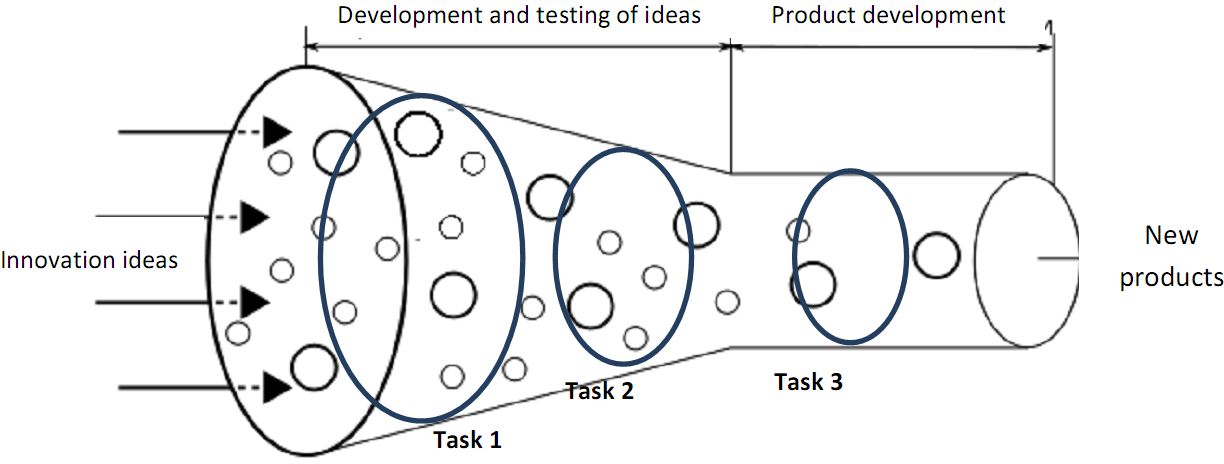
The innovation funnel solves the following three tasks:
1. Maximum widening of a fuel entry: involvement of a maximum number of participants. To this end, a company knowledge base and accessibility to different information sources should be expanded to increase a number of innovation ideas.
2. Development of target indices to narrow a funnel neck, i.e. to select most promising projects. It is necessary to use limited resources for most successful projects.
3. At the final project stages, a crucial task is to maximize the value of intellectual capital of a company by producing innovation products and distributing patents and licenses.
A funnel can be used to substantiate end purposes (production of innovation products and providing innovation services, creation of new businesses, start-ups and highly-qualified jobs). As far as many other authors have already described the process of funnel development (Ndonzuau, Pirnay, & Surlemont, 2002; Zoz, 2009), the present article does not deal with this issue.
To illustrate the model, data of the Fund for Promoting Innovation for 21 years were used. The model involves several funnel narrowing stages. At the first stage, more than 55 thousand applications were assessed, 13 thousand projects were financed, more than 5 thousand start-ups were created. In percentage terms, 23.6% of all the applications got financial support, and 9% of the applicants create start-ups.
The funnel can be developed for financing innovation ideas of business-angel investors or venture capitalists. In this case, selection involves several stages. The number of projects is reduced at each stage, and only 3% of the projects get financial support. The process which is based on the statistics of business angel structures is presented in Figure
As can be seen, at the first stage, more than 85% of all applications are filtered out.
Linear innovation process models are implemented by companies with a full cycle of new product or service development from research and development to commercialization. As a result, a company has unique technology which gives it competitive advantages. Venture business development contributes to creation of a large number of companies developing innovation products which escalates competition, and in some markets, small businesses, owing to their mobility become dominant.
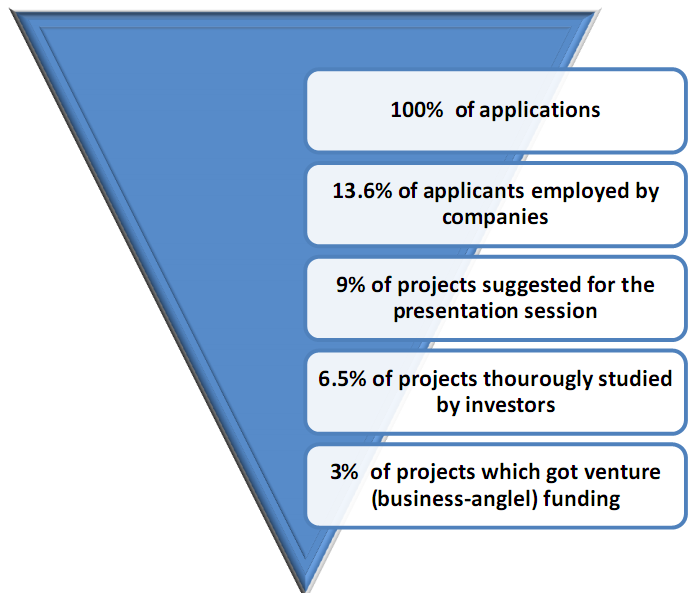
Innovation funnel model for open innovation products.
Escalation of competition and high profitability of investment in innovation activities changed views on an innovation process model. The book Open innovation – The New Imperative for Creating and Profiting from Technology (2003) by Henri Chesbro changed the concept of innovation activities. The model for innovation development is described as an open system, and a company can use all possible ideas (own ideas or ideas developed by other organizations) for creating innovation products (Chesbro, 2007). If an innovation idea does not correspond to a company business model, it should be sold to other companies or distributed under a license rather than hidden. In those industries where distribution of know-how ideas can be dangerous for the society, an open innovation model should not be used. Exceptions are possible (e.g., conversion technology from the military industry or innovation products which can be used for military purposes). All other industries use an open innovation model which allows them to increase production volumes and develop new services and technology to be competitive in the market. However, the open innovation model has one drawback: due to fast development of competitors, companies are unable to keep leading positions in the market for a long time. Competition in the open innovation model is more aggressive and violent (Berkhout & Van Der Duin, 2007).
Open innovation development changed an innovation funnel model which can be presented in a more complex form when the process is open (Cooper, 2001). The funnel which is based on the open innovation model can be presented as a diagram (Figure
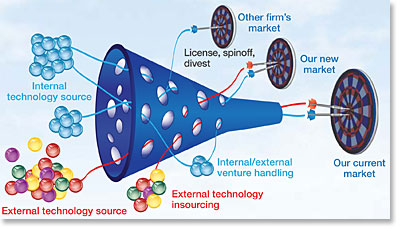
The diagram shows that input innovation ideas are external and internal technology sources. When passing through the funnel stages, a need for external technology can occur. It can result in commercialization of a new product which was a target of the model. However, two more secondary targets appeared: distribution of licenses and creation of spin-off companies (Innovative entrepreneurship: how the venture "ladder" works, 2010), and entry into new markets.
Findings
An example of the innovation funnel in the open innovation model is the UMNIK program by the Fund for Promoting Small R&D Businesses. Ideas can be suggested by students (students are target funnel objects) and young researchers of the Academy of Sciences, engineers of business companies, etc. aged 18-30 years. Longstanding researches carried out in universities or research institutes, innovation ideas resulted from market needs can also become sources of ideas. Winners of the program UMNIK can use earlier created innovation products and technology. The main target of the program is to create a small innovation business based on the innovation product developed or employment of a researcher in an innovation-based company producing those innovation products. Research activities, defense of a PhD thesis, development of new research areas in universities and research institutes are also considered target results of the program.
The model was approbated at conferences as a part of the UMNIK program in Irkutsk oblast. As a result of selection processes which were a part of the Fourth and Fifth Interregional Youth Scientific and Practical Conferences “Baikal as an innovation territory” held in Irkutsk in October 2016 and November 2017; key stages of the innovation funnel model were identified and their statistic parameters were calculated.
The model involves the following stages:
1. Online submission of applications by young researchers through the UMNIK system. The number of applications was 81.
2. About 13% of applicants were not able to fill in all fields of the application. According to the survey, they need to develop further their ideas and determine key parameters.
3. Some projects got low expert marks, which speaks for their poor development and low quality of applications submitted (about 5%).
4. Only 24% of the applications reached the semifinal (it is also due to the restriction of final participants).
5. Winners were 10% of the applicants. Each of them won 500 thousand rubles for two-year innovation project development.
6. According to statistics, only 1% of the applicants will create innovation-based enterprises.
The open innovation funnel is presented in Figure
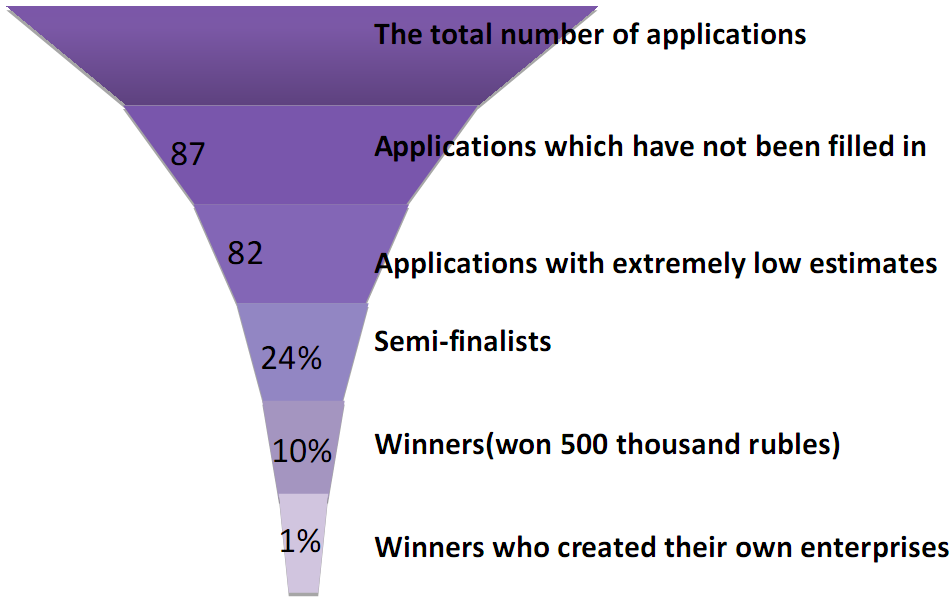
The model for engaging students in research and innovation activities (Dneprovskaya, Shevtsova, Byaskalanova, & Lutoev, 2016) can be developed using the above-described models.
The peculiarity of the model is a limited number of students with their own innovation projects. The open innovation model allows for projects from other universities whose number does not exceed 5%. If project development requires skills which the university lacks, experts from other universities or research institutes can be involved in the project. At the development stage, public programs for supporting students and young researchers play a crucial role. UMNIK is the most popular program. Other programs (regional, municipal, university) develop innovation projects in the areas which these infrastructure entities are interested in. Their financial resources help move to the next stage of the innovation funnel which involves research and development and engineering activities. Only participants who got financial support can move to the next stage and can carry out researches in research laboratories of the university. As a result, a commercially successful product can be developed. To enter the market, sell licenses, or create enterprises, private investment resources can be used. Output results of the innovation funnel are as follows:
Creation of a new enterprise with the involvement of the university (selling of intellectual property licenses). The process was described in [12].
Selling of licenses to medium or large businesses, creation of joint companies with university intellectual property objects and personnel (researchers and students) and capital assets (buildings, equipment, workers, etc.) or financial resources of business companies.
Employment of a student or a researcher in a business company, a large industry or a government agency. It speaks for efficient training of the student during project implementation. Involvement in innovation projects helps train qualified professionals. For the economy, that result is more important than other ones because it allows implementation of university projects in a wider form due to innovation diffusion.
The implementation diagram for the university innovation funnel is presented in Figure
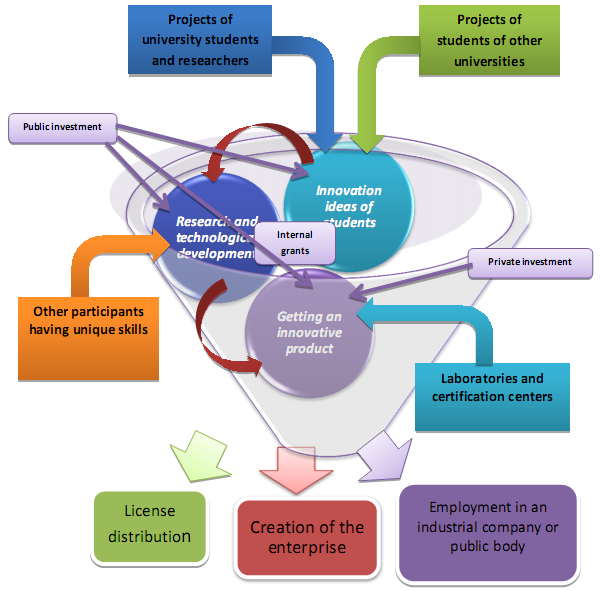
These three stages are rather relative as the internal funnel mechanism is different in each university, but its key interaction parameters remain the same.
Conclusion
Theoretical research and approbation of the models allow the following conclusions:
Non-linear models, open innovation models and innovation funnels can be used for university innovation activities.
Efficient development of university innovation projects cannot do without public investment at initial stages, and private investment at final stages of innovation development.
University innovation projects cannot be implemented without involvement of external organizations.
University innovation activities can result in creation of enterprises or distribution of licenses or know-how ideas.
Successful employment of alumna depends on their engagement in university innovation projects.
It should be noted that the open innovation model is adequate description of university innovation project development and implementation. The innovation funnel describes most university innovation activities, their features and functions. The model can become a basis for university innovation development policies and strategies.
Acknowledgments
The research was supported by the grant of the President of the Russian Federation according to state support of leading scientific schools (grant № NSh-5449.2018.6).
References
- Berkhout, G., Van Der Duin, P. (2007). New ways of innovation: an application of the cyclic innovation model to the mobile telecom industry. International journal of technology management.Vol. 40, № 4, 294-309.
- Bogdanovich, O.I., Merkulov, A.S., Ruposov, V.L. (2015). The role of universities in economic development. Bulletin of Perm University. Economics, 2 (25). P. 15-21.
- Chesbro, G. (2007). Open innovation products. Moscow: Pokolenie, 336.
- Cooper, R.G. (2001). Winning at new products. Accelerating the process from idea to launch [Text] / R.G. Cooper. Cambridge (MA): Perseus Publishing.
- Dneprovskaya N., Shevtsova, I, Byaskalanova, T. and Lutoev, I (2016). Knowledge Management Methods in Online Course Development. Proceedings of the 15th European Conference on eLearning. — Academic Conferences and Publishing International Limited UK, pages 156- 165.
- Fund for Promoting Innovation. (2017). Retrieved from: http://www.fasie.ru/
- Innovative entrepreneurship: how a venture ladder works (2010). Proceedings. Moscow: OAO Russian Venture Company, Business journal, 64.
- Ndonzuau, FN, Pirnay, F. and Surlemont, B. (2002). A stage model of academic spin-off creation. Technovation, 22 (5), 281-289.
- QS World University Rankings. (2017). Retrieved from: https://www.topuniversities.com/university-rankings/world-university-rankings/2018.
- Rankings of universities. (2017). Retrieved from: https://www.ugent.be/en/ghentuniv/organization/presentation/rankings.htm#reuters-top-100--world-s-most-innovative-universities.
- Smyshlyaeva, E.O., Kovalnova, N.M., Sokolov, S.S. (2016). Studies on the international rating system Webometrics as a tool for enhancing research activities and university presence in the Internet. Vestnik of State University of Sea and River Fleet n.a. Admiral Makarov. Issue 3 (37), 233-241.
- Times Ranking. (2017). Retrieved from: http://www.universityrankings.ch/fields/Times/rank_business/.
- Wheelright, S.C. (1992). Revolutionizing Product Development: Quantum Leaps in Speed, Efficiency and Quality [Text] / S.C. Wheelright, C. Steven, B. Clark Kim, eds. New York: Free Press, 1992.
- Wissema, J. G. (2009). Towards the third generation university: managing the university in transition / J. G. Wissema. Cheltenham; Northampton: Edward Elgar, 252.
- Zoz, R.A. (2009). Innovation investment model development based on an innovation funnel. Bulletin of Saint Petersburg University of Management and Economics, 2, 24, 163-170.
Copyright information

This work is licensed under a Creative Commons Attribution-NonCommercial-NoDerivatives 4.0 International License.
About this article
Publication Date
17 December 2018
Article Doi
eBook ISBN
978-1-80296-049-5
Publisher
Future Academy
Volume
50
Print ISBN (optional)
-
Edition Number
1st Edition
Pages
1-1464
Subjects
Social sciences, modern society,innovation, social science and technology, organizational behaviour, organizational theory
Cite this article as:
Ruposov, V., Bayaskalanova, T., Belikov, A., & Urintsov, A. (2018). University Innovation Funnel Model. In I. B. Ardashkin, B. Vladimir Iosifovich, & N. V. Martyushev (Eds.), Research Paradigms Transformation in Social Sciences, vol 50. European Proceedings of Social and Behavioural Sciences (pp. 156-164). Future Academy. https://doi.org/10.15405/epsbs.2018.12.20

